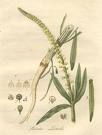
In pure form the colourant luteolin, which is found throughout the mignonette plant, forms small, yellow, gleaming crystals. These dissolve in water with difficulty but are soluble in soda, potash and ammonia solution, yielding a deep yellow colour. Like many other yellow plant dyes, luteolin belongs to the flavone family. The substance is regarded as one of the most lasting yellow plant dyes. It is only completely light-fast and permanent on pure silk, however. On cotton it does not hold its colour so well.

History
Seeds of the plant have been found in lakeside settlements of the late Stone Age (8000 BC) near Robenhausen on Lake Pfäffikon in Switzerland. Also known as dyer's rocket, it may be assumed that the plant was used for dyeing from an early stage, along with madder and indigo. It is probable that the Romans too used the yellow colourant to dye their wedding garments. The Roman poet Vergil mentions a certain "yellow herb" ("herba lutea"). The first written instructions for using the plant as a dye date from the 8th century AD, being found in formulations for the use of southern Italian craft workers. In the 17th century the plant was widely cultivated in the south of England, principally for processing in London's dye factories. In Germany mignonette plantations were to be found in Thuringia, Saxony, Bavaria and Württemberg. The plant was used to dye silk right into the 20th century. Later on the natural dye was almost completely superseded by synthetic substitutes. Today the plant grows wild all over Europe, having a particular predilection for railway embankments.